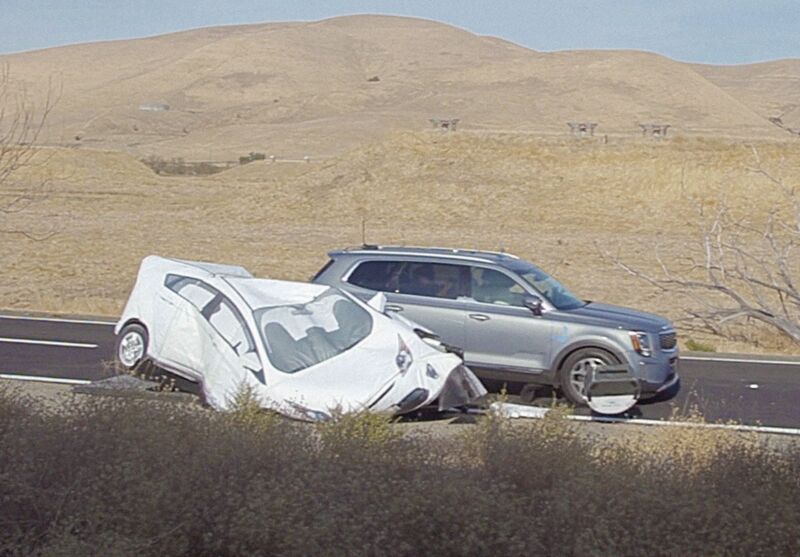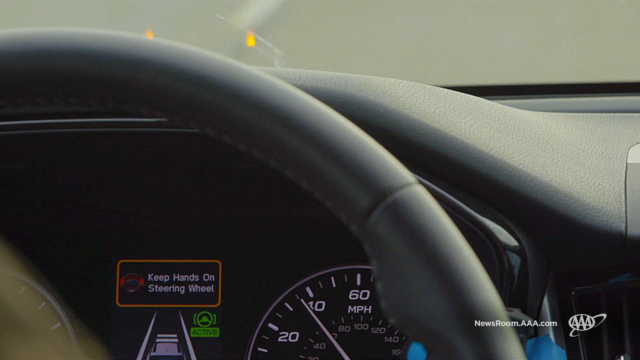
In recent years, a number of auto companies (such as Tesla) have begun to integrate driver assistance systems into their vehicles that can keep track of the lane and provide cruise control. All of these developments seem like a big step towards self-driving, since a vehicle with such systems can travel many miles on highways without human intervention. However, a new report from the American Automobile Association ( AAA ) highlights the limitations of these systems.
The most dramatic finding is that ADAS systems in newer vehicles still struggle to avoid collisions with parked cars. AAA tested BMW, Kia and Subaru vehicles, and none of them were able to avoid collisions with a mock car that partially occupied the lane.
The researchers also examined the ADAS systems in the Cadillac CT6 and Ford Edge, although the systems of these cars were not included in the parked car tests because their driver assistance systems did not work on the AAA test site. They were included in other tests carried out on public roads.
"All test drivers agreed that the combination of adaptive cruise control and lane control is not conducive to driving excellence," the report said. The vehicles made mistakes quite often, and for drivers the experience of such trips was more stressful than relaxing.
Greg Brannon, co-author of the AAA report, argues that the fundamental problem with such systems is the need to keep the driver alert. Once behind the wheel of a car that can drive almost independently, people begin to be terribly distracted from the road. That is why there is a great risk that when (or if) this system makes a mistake, the driver will be distracted and unable to quickly take control and save the situation.
Why do ADAS systems keep crashing into parked cars?

You may decide that vehicles with adaptive cruise control or emergency braking will stop when approaching parked vehicles and other obstructions on the road. The point is, they often don't. To understand why, it is helpful to understand a little about how these systems work.
Most of the early adaptive cruise control systems sold 10-20 years ago were radar based. And as we explained two years ago, radars have a number of important limitations:
“ , . , . , , . , - : , , , .
, ( ), . - , , , .”
This is why cars have been programmed so that their systems are designed to maintain a safe distance from other moving objects (cars) and to ignore stationary objects. The engineers assumed that the driver would still be obliged to monitor the road and take control if an obstacle arises on the roadway.
Today's driver assistance systems are more sophisticated than earlier designs that hit the market 10 or 20 years ago. They are no longer based on radar alone. Many modern systems are based on cameras, and it seems that these systems are trying to use both radars and cameras to detect potential obstacles.
Indeed, systems in modern cars seem to do a better job of this than previous designs. In the AAA test, the system used in the 2020 Subaru Outback performed best. The AAA conducted three test drives on the Outback at a starting speed of 30 mph. The vehicle stopped on two of the three test drives. During the third attempt, the car crashed into a dummy, but before that it still slowed down.
In the same test, the 2019 BMW X7 stalled in only one of three attempts, and the 2020 Kia Telluride crashed into a dummy on all three runs at 30 mph. Both cars slowed down somewhat before the collision during other test runs.
In other words, all three machines are somewhat capable of detecting imminent collisions and at least mitigating them. This ability represents an enhancement to the capabilities of early radar-based systems. However, none of these systems were advanced enough to avoid a collision with a parked car.
It's not just the autopilot in Tesla that suffers from parked cars

Tesla Model S Driving Down the Highway in Silicon Valley
All this gives Tesla fans (their cars got media attention due to ADAS errors) a number of arguments for their cars. At least three Tesla owners have died as autopilot vehicles crashed into a concrete lane divider (one case) and left their lane (two other cases). Also, several Tesla cars crashed into police and fire trucks. Tests carried out by AAA have shown that such problems are not limited to Tesla vehicles.
I asked AAA's Greg Brannon if he knew about accidents caused by ADAS errors in other brands of cars - and he said he was not aware. It is unclear why. Perhaps Tesla and their autopilot are simply on the market longer. Or perhaps accidents involving Tesla vehicles have received more media coverage, and accidents involving other cars from other brands simply did not get into the general field of view. Brannon noted that the National Transportation Safety Board has investigated several fatal accidents involving Tesla vehicles on autopilot. And it doesn't appear that the agency has investigated accidents involving other automakers' ADAS technology.
This may change in the coming years as other companies sell more and more vehicles with the capabilities provided by Tesla's autopilot system. All of these new car models appear to have the same limitations as Tesla's cars.
Highway performance

Tests with a parked vehicle demonstrated ADAS failures most dramatically. But the AAA tests didn't stop there. At its indoor training ground, the AAA tested whether Subaru, BMW and Kia vehicles would be able to maintain lane control, lane control, and braking response from a vehicle in front. All three machines had some difficulties in this test scenario. Recall that cars from GM and Ford had restrictions on the area of operation, because of which their ADAS systems did not even turn on.
The researchers also tested the performance of various systems of five vehicles on public roads. Test drives exceeded 800 miles, and BMW, Kia and Subaru drivers had to take control dozens of times, often as the cars began to leave their lane.
Cadillac's Super Cruise system handled differently. The drivers of these vehicles took control only eight times in 800 miles due to concerns that the car was not properly controlling the lane. However, the system behaved rather conservatively in terms of sudden outages. The tests recorded "37 cases of erroneous or unexpected system shutdown."
“Sometimes test drivers were caught off guard and had to take full control of critical situations that were not alerted,” the AAA said in a report.
Super Cruise is different from most other driver assistance systems because it uses a camera aimed at the driver to ensure that drivers are watching the road. (Subaru has a similar system called DriverFocus, but Brannon said drivers didn't see much of a camera being used.) ... A camera in Cadillac cars tracked the direction of the driver's gaze and tried to assess whether the driver was paying attention to the road. AAA found this system to be far from perfect; in some cases, Super Cruise passed control to the driver because it mistakenly assumed that the driver was distracted.
All of this suggests that there is a need to discuss the Cadillac approach that we have already praised. Super Cruise is a conservative decision-making system, and at the first sign of trouble passes control back to the driver. This scheme of work not only minimizes the chances that the system will make a mistake, but also encourages drivers to monitor their own car more closely.
"Permanent control and participation in management"

At the same time, AAA found that a Kia Telluride driver can take his hands off the wheel for a full two minutes. Worse, the gauges on the dashboard were “easy to miss due to the hidden icons,” and this poses a risk that the driver could be confused about whether ADAS is working or not.
The Subaru Outback system "often issued a lane departure warning and turned off at the same time." Occasionally, this happened in a tight corner, which can create an increased risk of an accident if the driver does not have time to quickly take control.
In the end, none of these systems received rave reviews from AAA testers. Drivers reported that these systems "can sometimes increase the workload of the driver noticeably, as in many cases constant control and participation is required."
This state of affairs could become a fundamental problem with the current approach to ADAS technologies. These systems are supposed to take over the bulk of driving, but the driver must monitor the system and make sure it does not make any mistakes. The problem is that our brains are not used to such monotonous work. Keeping track of a system that is working correctly 99% of the time of use is sometimes more difficult (certainly not easier) than just driving on your own. And it is so difficult to keep track of such systems precisely because our brain has many opportunities to be distracted by something.
Subscribe to the channels:
@TeslaHackers - a community of Russian Tesla hackers, rental and drift training on Tesla
@AutomotiveRu — ,

- automotive . 2500 , 650 .
, , . ( 30, ), -, -, - (DSP-) .
, . , , , . , automotive. , , .
, , . ( 30, ), -, -, - (DSP-) .
, . , , , . , automotive. , , .
:
- - Automotive, Aerospace, (50+)
- [] (, , )
- DEF CON 2018-2019
- [] Motornet —
- 16 , 8
- open source
- McKinsey: automotive
- …